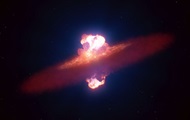Astronomers have for the first time recorded the birth of a supernova: unique footage of the explosion.


Astronomers have managed to capture the first moments of a supernova explosion in history, including the moment when the shock wave breaks through the surface of the dying star. Previously, scientists could only model these events, as the initial phase lasts only a few hours and was effectively inaccessible for observation. The rapid response of the European Southern Observatory (ESO) played a crucial role in this, as they canceled all planned work immediately after the supernova was detected and allocated their most powerful telescope to a team of researchers in Chile.
Detection of the Supernova
The supernova SN 2024ggi was detected on April 10, 2024, in the galaxy NGC 3621, located approximately 22 million light-years from Earth. This explosion originated from a red supergiant with a mass of 12-15 solar masses and a radius 500 times that of the sun. This scenario reflects the general process of the death of massive stars. The scientists requested urgent observations within the first hours after the discovery, and less than 12 hours later, they received permission.
On April 11, just 26 hours after the discovery, the object was observed using the VLT telescope; this provided the opportunity to capture a unique moment – the initial breakthrough of the shock wave through the star's shell. After this, the supernova rapidly transformed into an opaque ball of plasma, where the initial details could no longer be preserved.
Research Methods
The analysis used the spectral polarimetry of the FORS2 instrument, the only one in the Southern Hemisphere capable of such measurements. This technique allows the determination of the explosion's shape: in spherical objects, the polarization of light is compensated, and its presence indicates the asymmetry of the process.
The research helped not only to capture the breakthrough of the shock wave but also to determine the geometry of the explosion. It turned out that the initial impulse was not spherical but had the shape of an olive — elongated and somewhat compressed, which changed during the interaction of the expelled stellar material with the surroundings. The explosion maintained clear axial symmetry.
The results obtained indicate a universal physical mechanism characteristic of many massive stars: core collapse, shock wave rebound, and its propagation along a certain axial scheme. This new observation refutes some previous models and clarifies others, providing the opportunity to confirm the real picture for the first Time, rather than just theoretical calculations.
Recall that it was previously reported that comet 3I/ATLAS surprised scientists: its brightness increased twice as fast.
Powerful Solar Flare: NASA Rescued Russian Astronauts on the ISS
News from Korrespondent.net on Telegram and WhatsApp. Subscribe to our channels.
This discovery is of great significance for astronomy, as it allows for new data to be obtained about the stages of star death and the physical processes occurring during such explosions. By understanding these mechanisms, we will be able to learn more about the dynamics of massive stars and the impact of their explosions on the surrounding environment.
Read also
- Honda Pilot 2026: the first facelift and fully digital dashboard
- Nissan has unveiled a new plug-in hybrid Rogue: what it has inherited from Mitsubishi
- Poland Launches Its First Military Satellite: Mission Details with SpaceX
- Artificial Intelligence at Work: How Employees Can Resist Pressure
- OpenAI launches group chats in ChatGPT: what changes for users
- Diya temporarily not working due to rush for 1000 hryvnias: what to do









